“Hi everyone, I just got a new SPYPOINT trail camera and I'm really excited to start using it! However, I'm a little unsure about how to format the SD card. Can someone guide me through this? I know it's important to format the card before using it, but I'm not sure how to do it. Any tips on how to format SPYPOINT SD card would be really appreciated!"
In this comprehensive guide, we'll walk you through everything you need to know about formatting SD cards for your SPYPOINT camera. Whether you're dealing with a standard SD card or a micro SD card, we've got you covered.
We'll explore various methods to format SD card, discuss the importance of proper formatting, and provide tips to help you get the most out of your trail camera.
In this article
Part 1: Overview of SPYPOINT link Micro SD Card Format
Before we get into the specifics of how to format SPYPOINT SD card, it's essential to understand what we mean by SPYPOINT link micro SD card format. SPYPOINT, a leading manufacturer of trail cameras, recommends using specific types of SD cards in their devices for optimal performance.
These cards, when properly formatted, ensure that your camera can read and write data efficiently, maximizing storage capacity and minimizing the risk of data corruption.
The SPYPOINT link micro SD card format refers to the way data is organized on these small, portable storage devices, making them compatible with SPYPOINT cameras and ready to capture high-quality images and videos of wildlife.
Part 2: Key Features Explained: SPYPOINT Micro SD Card
When it comes to choosing and formatting SD cards for your SPYPOINT camera, it's helpful to understand their key features. Here's a breakdown of what makes SPYPOINT micro SD cards special:
- Capacity: SPYPOINT cameras typically support SD cards up to 32GB, providing ample storage for thousands of images or hours of video.
- Speed: These cards offer fast read and write speeds, ensuring quick data transfer and smooth camera operation.
- Durability: Designed for outdoor use, SPYPOINT SD cards can withstand extreme temperatures and harsh conditions.
- Compatibility: They're specifically formatted to work seamlessly with SPYPOINT cameras, reducing the risk of errors.
- File System: SPYPOINT SD cards usually use the FAT32 file system, which is optimal for the camera's functionality.
- Reliability: When properly formatted, these cards minimize the risk of data loss or corruption.
- Easy to Format: The process to format SPYPOINT micro SD card is straightforward, whether done in-camera or on a computer.
Understanding these features will help you appreciate the importance of proper formatting and care for your SPYPOINT SD cards.
Part 3: How to Format SPYPOINT SD Card
Now that we've covered the basics, let's get into the heart of the matter: how to format SPYPOINT SD card. We'll explore two primary methods: using the camera settings and using a PC. Both methods are effective, and the choice often comes down to personal preference or convenience.
Method 1: Use the Camera Settings
Formatting your SD card directly in your SPYPOINT camera is often the easiest and most recommended method.
Here's a step-by-step guide on how to format SPYPOINT SD card using your camera:
Step 1: Press and hold the FORMAT button on the camera for five seconds while the status LED is blinking green.
Step 2: Reboot the camera. Check the LED patterns. If there are no MicroSD card issues, press the TEST button.
Remember, formatting your SD card will erase all data on it, so make sure to back up any important files before proceeding.
This method ensures that your SD card is formatted in a way that's optimally compatible with your SPYPOINT camera. It's the quickest and most foolproof way to format SPYPOINT micro SD card, especially if you're in the field and don't have access to a computer.
Method 2: Use a PC
If you prefer to format your SPYPOINT SD card using a computer, or if you're having trouble formatting it in the camera, here's how you can do it:
Step 1: Remove the SD card from your SPYPOINT camera. Insert the SD card into your computer's card reader. If your computer doesn't have a built-in card reader, you can use an external USB card reader. Open File Explorer (Windows) or Finder (Mac). Locate your SD card. Right-click on the SD card icon (Windows) or Control-click (Mac). Select "Format" from the drop-down menu.
Step 2: In the Format window, make sure to select FAT32 as the file system. This is the format that SPYPOINT cameras typically use. You can give your SD card a name in the "Volume Label" field if you wish. Click "Start" to begin the formatting process.
Step 3: Wait for the process to complete. Once done, safely eject the SD card from your computer and reinsert it into your SPYPOINT camera.
This method of formatting SD card for SPYPOINT can be useful if you're preparing multiple cards at once or if you're more comfortable using a computer interface. However, be cautious and make sure you're formatting the correct drive to avoid accidentally erasing data from other storage devices.
Part 4: Lost your Precious Files from SPYPOINT SD Card? Try Recoverit Today!
Mistakes happen, and SD cards can fail. Don't panic if you've accidentally formatted or corrupted your card. Don’t worry. There are solutions available to help recover your lost files.
One highly recommended tool for data recovery is Recoverit. This powerful software is designed to recover lost or deleted files from various storage devices, including SD cards used in SPYPOINT cameras.
Here's why Recoverit might be your best bet for recovering lost data:
- High Recovery Rate: Recoverit boasts a high success rate in recovering lost files, even from formatted or corrupted SD cards.
- User-Friendly Interface: The software is designed to be easy to use, even for those who aren't tech-savvy.
- Supports Multiple File Types: Whether you've lost photos, videos, or other types of files, Recoverit can help recover them.
- Preview Function: You can preview recoverable files before initiating the recovery process, ensuring you're getting back the files you need.
- Safe and Secure: Recoverit performs read-only operations, meaning it won't cause further damage to your SD card during the recovery process.
To use Recoverit to recover files from your SPYPOINT SD card:
Step 1: Install Wondershare Recoverit on your computer. Connect your SD card to your computer using a card reader. Launch Recoverit and select your SD card as the location to scan. Click Start.
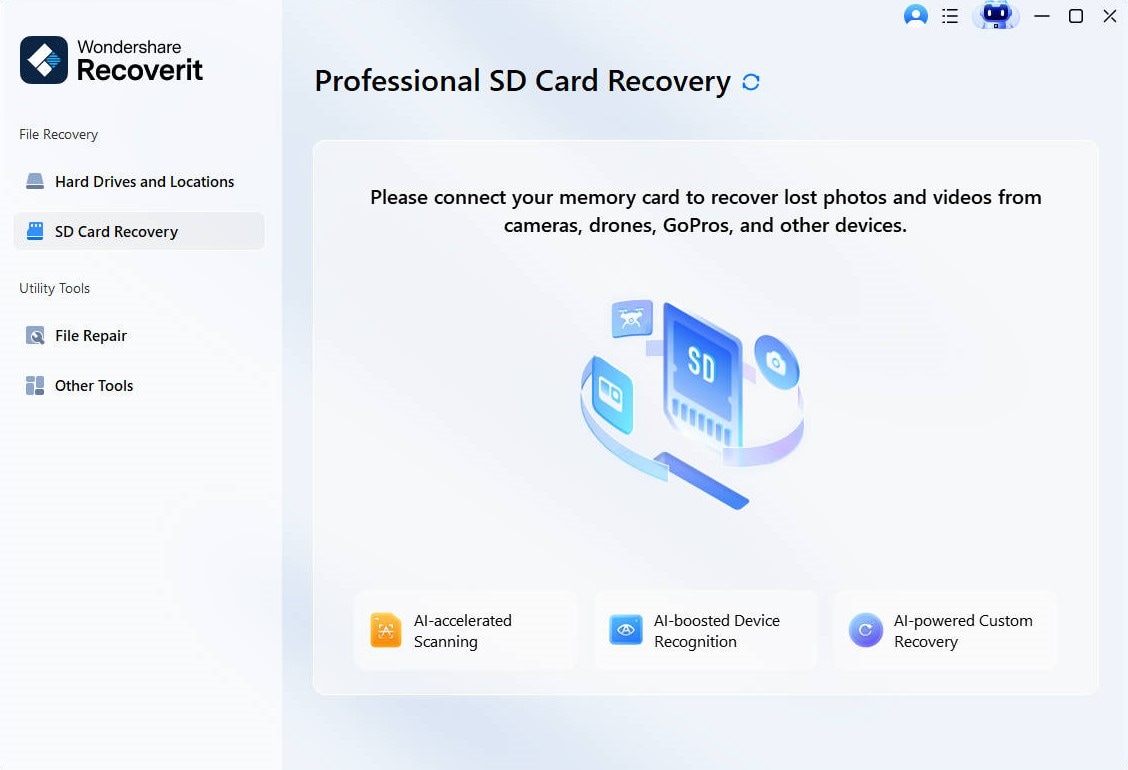
Step 2: Hit the “Scan” button.
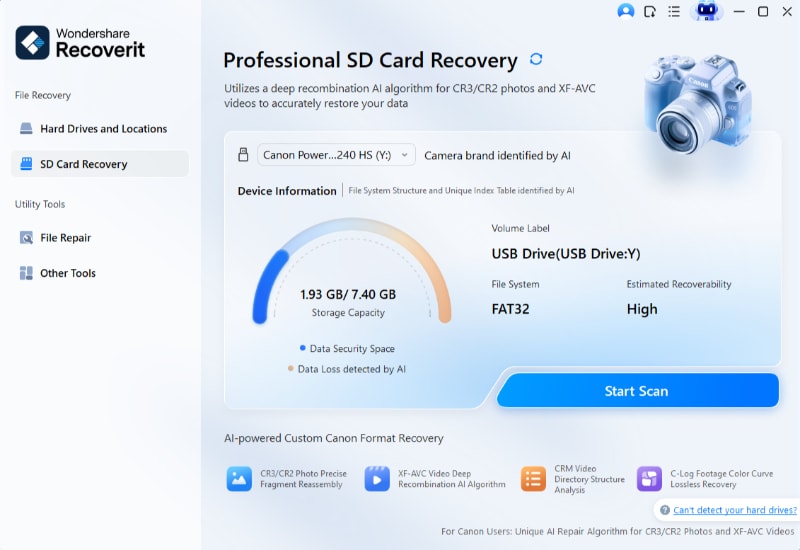
Step 3: Wait for the scanning process.
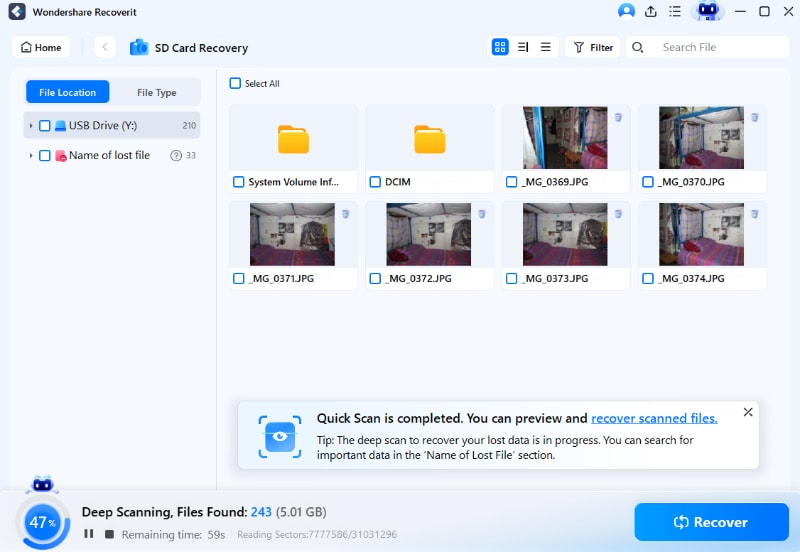
Step 4: Preview the recoverable files. Select the files you want to recover and click "Recover" to save them to your computer.
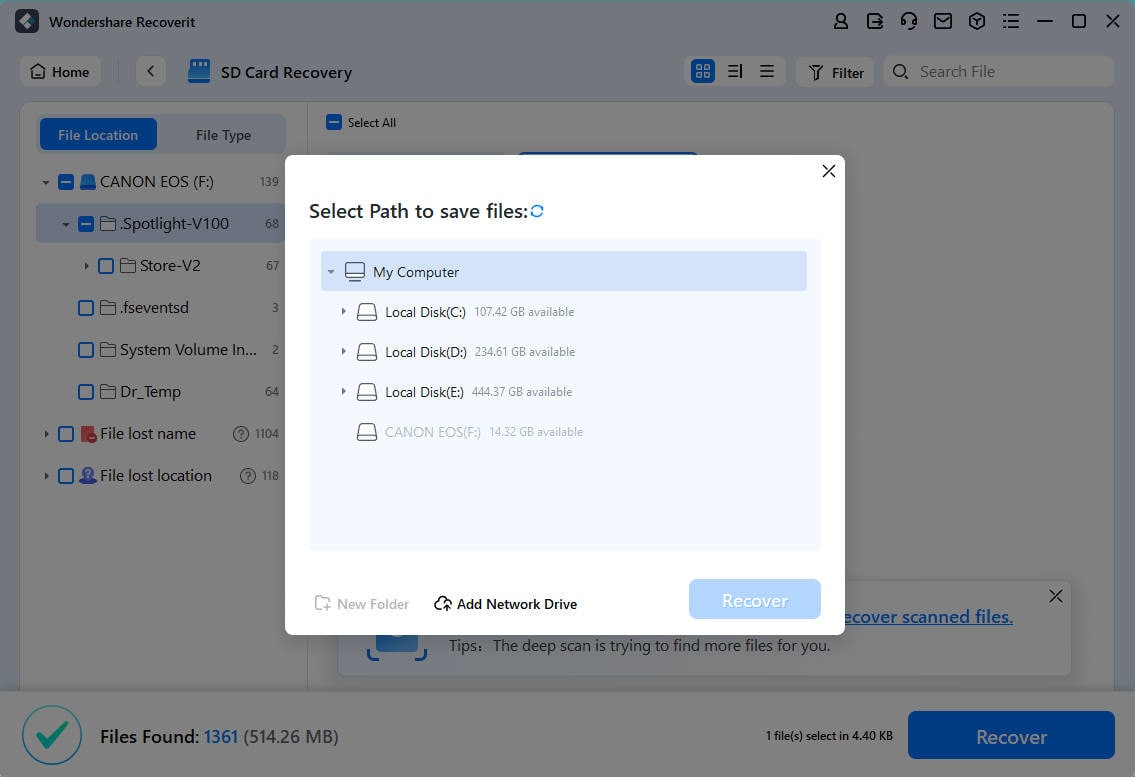
Remember, the sooner you attempt to recover your files after losing them, the better your chances of success. Avoid writing new data to the SD card until you've recovered your lost files, as this could overwrite the data you're trying to recover.
Part 5: Tips to Format SPYPOINT Micro SD Card Like a Pro
Now that you know how to format SPYPOINT SD card, let's explore some pro tips to ensure you're getting the most out of your trail camera and SD card:
- Format Regularly: It's a good practice to format your SD card every time you empty it of images or videos. This helps maintain the card's performance and reduces the risk of data corruption.
- Use the Camera to Format: Whenever possible, use your SPYPOINT camera to format the SD card. This ensures the card is formatted in a way that's optimally compatible with your specific camera model.
- Backup Before Formatting: Always backup your important files before formatting. Remember, formatting erases all data on the card.
- Check Compatibility: Ensure your SD card is compatible with your SPYPOINT camera model. Check the user manual or SPYPOINT's website for recommended card types and capacities.
- Avoid Filling the Card Completely: Try to keep some free space on your SD card. A completely full card can lead to performance issues.
- Handle with Care: When inserting or removing the SD card, be gentle to avoid damaging the card or the camera's card slot.
- Keep Cards Clean: Store your SD cards in a clean, dry place when not in use. Dust and moisture can damage the card and corrupt data.
- Use Write Protection: When transferring files to your computer, use the write-protection switch on your SD card (if available) to prevent accidental deletion or modification of files.
- Replace Old Cards: SD cards don't last forever. If you notice your card becoming slower or less reliable, it might be time to replace it.
By following these tips, you'll be formatting SD card for SPYPOINT like a pro in no time. Remember, proper SD card management is key to getting the best performance from your SPYPOINT trail camera and capturing those unforgettable wildlife moments.
Video Tutorial: How to Format SD Card?
Conclusion
Mastering the art of how to format SPYPOINT SD card is an essential skill for any trail camera enthusiast. Whether you're using the SPYPOINT link micro SD card format directly in your camera or formatting SD card for SPYPOINT on your computer, the process is straightforward once you know the steps.
By following the methods and tips outlined in this guide, you can ensure that your SPYPOINT camera SD card format is always optimal, allowing you to capture clear, high-quality images and videos of wildlife.
FAQ
-
How often should I format my SPYPOINT SD card?
It's generally recommended to format your SPYPOINT SD card after each use, or at least once you've transferred all the images and videos to your computer. Regular formatting helps maintain the card's performance and reduces the risk of data corruption. However, make sure you've backed up all important files before formatting, as the process erases all data on the card. -
Can I use any SD card in my SPYPOINT camera?
While many SD cards may work in SPYPOINT cameras, it's best to use cards that meet the manufacturer's recommendations. SPYPOINT typically suggests using Class 10 SD or micro SD cards with capacities up to 32GB. Using recommended cards ensures optimal performance and reduces the risk of compatibility issues. Always check your camera's user manual or the SPYPOINT website for specific SD card recommendations for your model. -
What should I do if my SPYPOINT camera won't recognize my SD card?
If your SPYPOINT camera isn't recognizing your SD card, try these steps: First, ensure the card is properly inserted. If that doesn't work, try formatting the card in the camera. If the camera still won't recognize it, try formatting the card on a computer using the FAT32 file system. If none of these steps work, the SD card might be damaged or incompatible with your camera. In this case, try using a different SD card that meets SPYPOINT's recommendations.
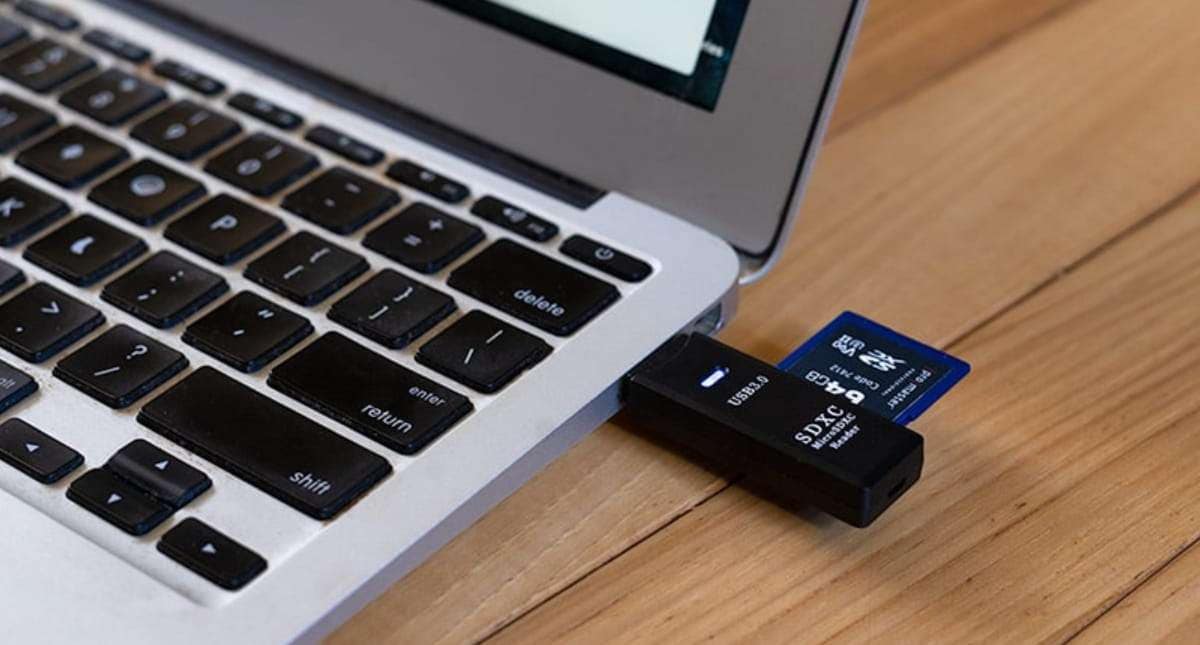


 ChatGPT
ChatGPT
 Perplexity
Perplexity
 Google AI Mode
Google AI Mode
 Grok
Grok























